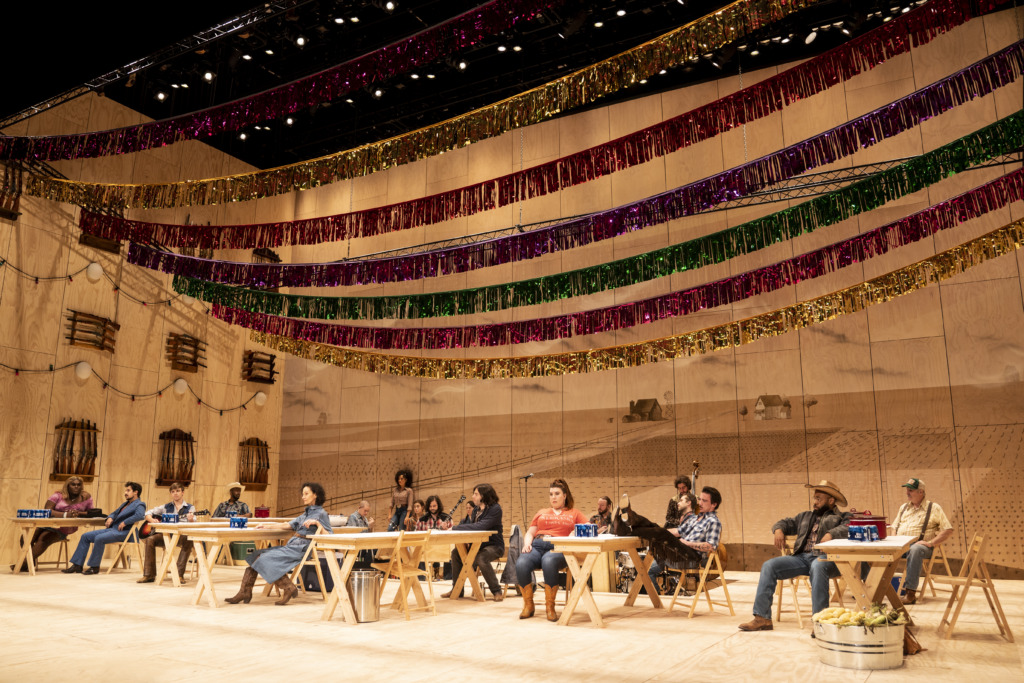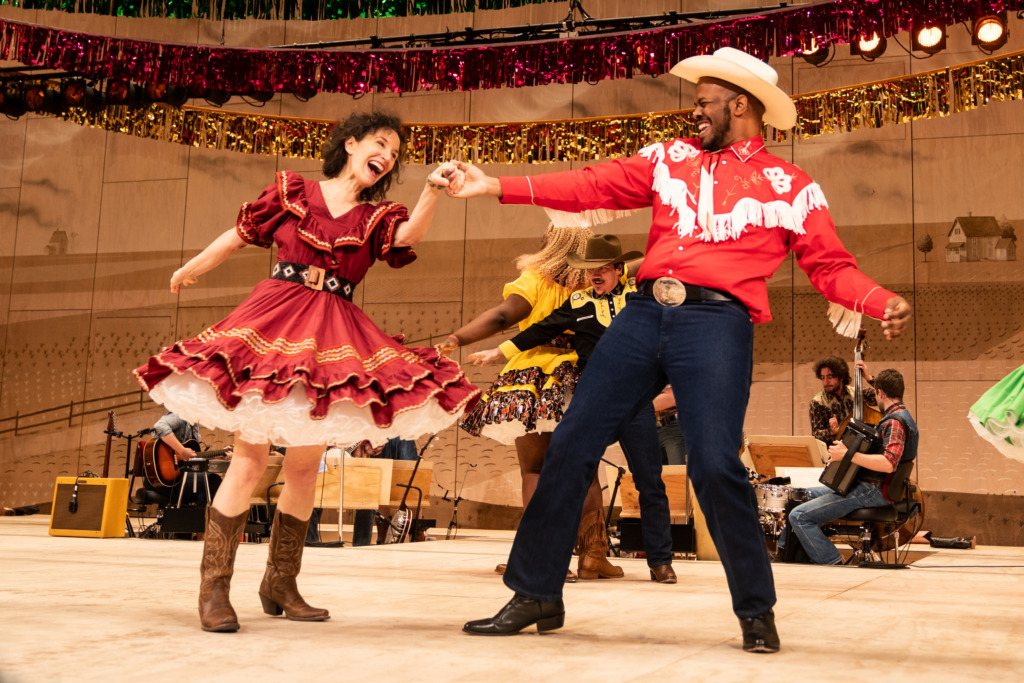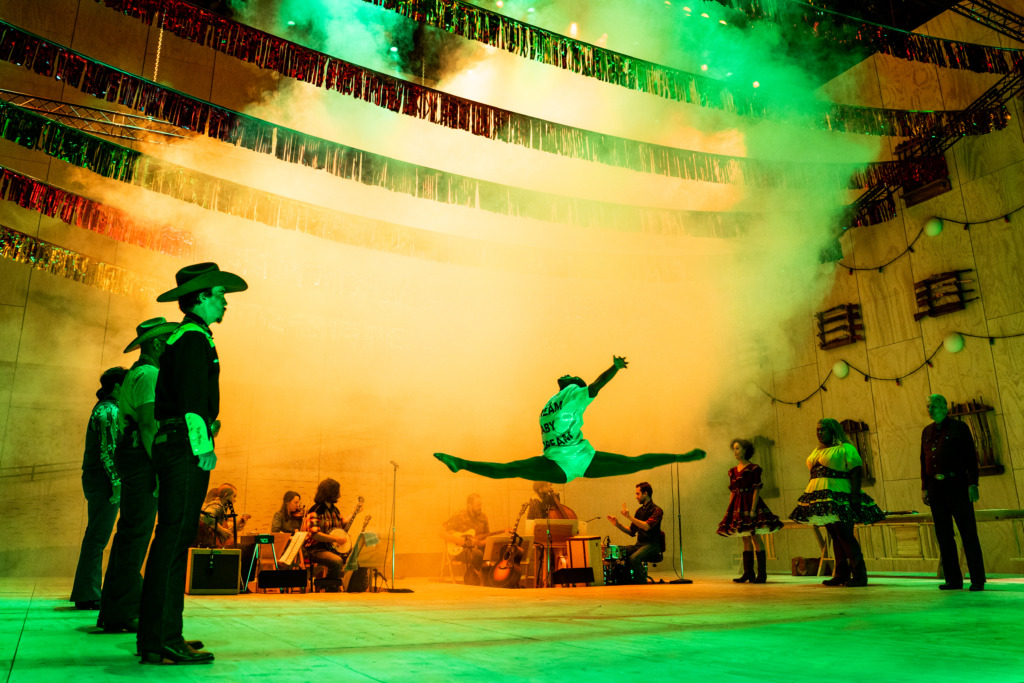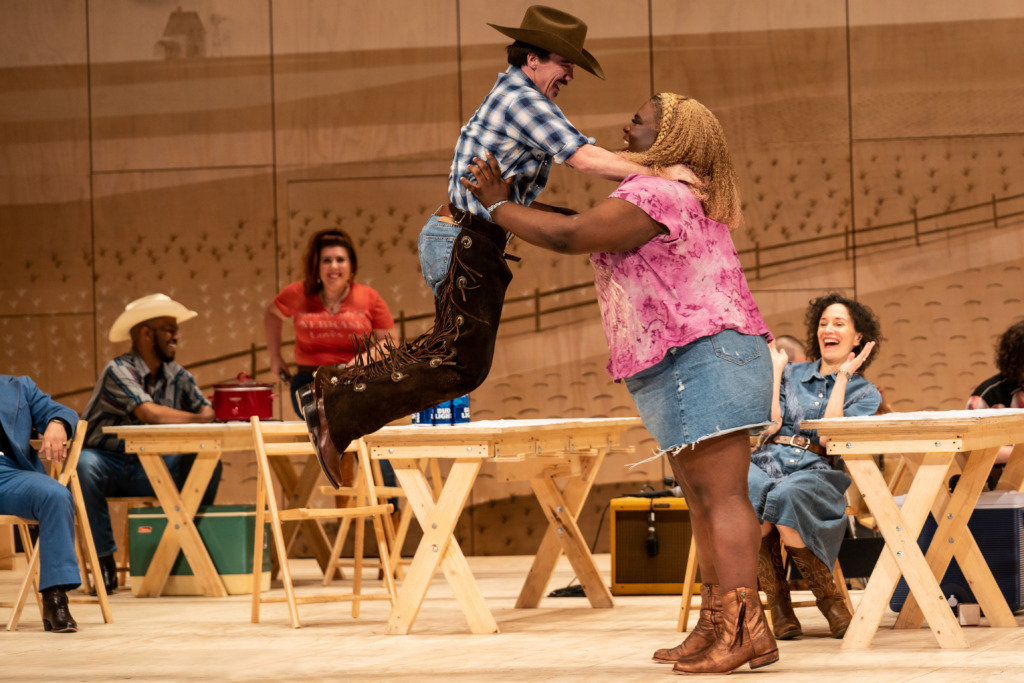Oklahoma! is now appearing on stage at The Kennedy Center’s Eisenhower Theatre. Directed by Daniel Fish, this ‘reimagined’ and ‘retooled’ production of the Rogers & Hammerstein classic is certainly unlike no production of Oklahoma! ever seen before. With questionable composition, extremely disjointed and half-finished concepts, mediocre talent across the vocal performance board, and an overall sloppy and unprofessional aesthetic, the production is one of the biggest disappointments since the return of live theatre to in-person viewing.

A combination of sloppy and slap-dash set design work (Scenic Designer Laura Jellinek) with poor blocking and sightlines alongside terribly balanced sound (Sound Designer Drew Levy) sets the production up for failure before the show even truly gets underway. The cast as it stands does not provide powerful enough vocals on their own, particularly when singing in solo or duet, to only be picked up by either body or drop mics, neither of which appeared to be set to actually pick up the voice of the actors. This was made inherently clear every time an actor would go to a hand mic or stand mic and their voices could be heard clearly over the live, on-stage string-band. This was a consistent problem throughout the performance, leaving songs sounding unsatisfying, ill-balanced, and ‘over-played’ by the stage band.
It should be noted that the stage band— Conductor/Accordian/Drums- Andy Collopy, Upright Bass- Dominic Lamorte, Mandolin/Electric Guitar- Rick Snell, Pedal Steel/Acoustic & Electric Guitar- Liz Faure, Banjo- Justin Hiltner, Violin- Libby Weitnauer, Cello- Grace Hartman Parce— were the only thoroughly, consistently impressive and enjoyable factor in this presentation. Their unique string-forward sound over the now barely-recognizable Rogers & Hammerstein score should be commended because it was the glowing highlight of the evening’s performance. Andy Collopy and his ‘squeezebox’ and Liz Faure on Pedal Steel are two of the standouts in the band.
Laura Jellinek has attempted to follow Director Daniel Fish down this disjointed rabbit-hole of devised modernity and ended up with a lackluster feeling that had the hopes of portraying a rustic-chic environment but fell short of the mark. Again Fish’s blocking of the show comes into play here as the tables and chairs end up being shuffled and bumped out of the way with actors tripping over them in a manner that does not at all appear to be intentional. The dazzling party streamers that frame the top of the set don’t seem to match anything else and don’t help draw the focus to the fact that this experience might be a celebration of some sort, which would also be in sharp and confusing contrast to the message that Fish and company are actually attempting to put forth. Jellinek’s scenic work lacks creativity, looks lazy, and will ultimately be called ‘minimalist’ but does not do the production any favors.
Director Daniel Fish failed to check the sightlines for the blocking of this show. (And if Fish isn’t in charge of sightlines, whoever is failed Daniel Fish.) There are a great many scenes, including some of the Dream Ballet and one particularly potent scene between Laurey and Curly, which end up being blocked to the upstage right corner (for those of you that don’t speak theatrical blocking— that is the far back corner, away from the audience, to the far left of what the audience can see) and in those moments a good third of the audience can’t see what’s going on. This doesn’t seem like an intentional choice to suspend one third of the audience’s experience but rather a lack of understanding the basic principles of ‘how to correctly block a show’. Even if this blocking faux pas weren’t taken into consideration, the movement of the characters— for the most part— is stagnant and shows poor understanding of the spatial relationships between characters, between set pieces, and between whatever concept Fish is trying to portray the most.
It should also be noted that the stagehand (and it is understood in productions— though often these are non-professional productions— that stagehands do exist, come on stage, and shift scenery, move props, etc.) is a jarring and disruptive presence whenever that individual comes on stage, wearing all blacks and fiddling around with the superfluous ‘live-food-and-beverage’ props that didn’t have any real purpose being on the stage in the first place. It looks unprofessional; at the very least the stagehand could have been put into some sort of plaid attire to blend in with those already on the stage. There’s no good excuse for having a stagehand, who clearly stands out as a stagehand, strolling into the middle of a scene— particularly in a sparse cast where said stagehand would be extremely noticeable whether they were disguised in cast-appropriate costuming or not— to pull unnecessary props out of the scene. (Why do we need real milk on stage? To slam Curley’s face into it because we’re desperately grasping at the straws of ‘comedy for the sake of being funny’? This does not make good theatre. Nor does flinging busted corn intentionally into the audience for the gag effect when the four female characters are singing “Many A New Day.” It’s a low-hanging fruit laugh that doesn’t serve the show, reads as juvenile, and seems like a waste of props.)

Conceptually the production is a disaster and there really isn’t a polite way to say that truthfully. If the intent of having all of the characters delivering their non-sung lines as dead-pan modernists with no hint of accent or vocal affectation, emotion or intention, while stumbling and tripping with their modern voices over the clearly dated libretto is some sort of overt attempt to point out just how ‘dated’ the show sounds? It fails to do that. Instead you’re left with cold actors sounding like they’re at a table read, discovering the text of the show for the first time and not in the ‘new and exciting’ vein of discovery. This concept almost works for the Aunt Eller (Barbara Walsh) character except once everyone starts speaking in a dull, disinterested delivery style, it loses its intention when being utilized by Aunt Eller. Barbara Walsh as Aunt Eller feels like a miscasting of the role because the musical director did no favors when it came to transposing her one musical solo into something more appropriate for her range. The score underwent major renovations to the point of almost not even sounding like Rogers & Hammerstein, including a great many transpositions for the varied vocal ranges of the diverse cast, but they seemed to leave Walsh’s number in a place she could not easily sing, which is astonishingly unfair to that performer.
Director Daniel Fish further dissects the production, as if trying to present a devised version of Oklahoma!, like something you might expect to see at an arts college festival, piecing it apart, deconstructing it, and attempting to reassemble it into his vision, only the pieces never really come back together. More than half the show is spent feeling out of joint with itself (on top of the poor sight lines, bad sound balance, and lackluster delivery and performances. The singers themselves were decent but not stellar, as one expects when hearing performers in leading roles on a show that’s touring through The Kennedy Center.)
And then the final 15 minutes of the production becomes a platform for social justice commentary, which is not only grossly overt (it stops just short of hitting the audience over the head with a sledgehammer in the way it’s trying to say ‘LOOK AT THIS SOCIAL THING I’M COMMENTING ON.’) but feels so far removed from everything that’s happened in this version of the show up until that point that it comes out of nowhere and not in the amazing and blindsiding surprised kind of way.
Fish has taken what is dismissably and fondly referred to as the R&H-Happy-Ever-After and turned it into a hot-spot of contention, bordering on the Star Wars “Han Shot First” debate. By staging the final wedding scene the way he does, with Judd doing what he does, drastically changes the context of the entire show. And you can ask your audience to suspend their disbelief to a point. And perhaps if the rest of the show had made any sort of sense or been clean, professional, and impressive by any measure, then this ending might have been the jaw-dropping gobsmacked moment it was intended to be. (Jeremy Chernick deserves all of the praise as the second-best element of the performance with the gun-shot-after effect.) The way this scene rolls through itself— clearly making an aggravated display of senseless gun violence, corruption in law authority, and silenced voices when it comes to both of these systemically broken institutions— leads the performers into what can only be described as a blind-hate-rage rendition of the title number, where they do prove they have the capability of projecting their voices. Choosing to withhold volume and vocal projection until this point in the show was a poor choice.

There is also too much time spent in literal darkness— the audience gets noticeably bored, starting to whisper and chatter amongst themselves as scenes are carrying on in complete darkness on the stage. It’s obvious on some level Fish (by poorly using Scott Zielinksi’s lighting design) was trying to show the audience the ‘darkness’ in which Judd Fry lives, both in his smokehouse and inside his mind. This could have more effectively been done without plunging the stage into total darkness for this untenable length of time. It was even implied that this level of darkness was lingering so that some grand scene change could take place, but when the lights finally came back up, nothing on stage had shifted.
In a smaller, blackbox theatre, with a much more intimate house, this trick may have been more successful. This draws attention to another problem with the infinite darkness design during the scene where Judd and Laurey become questionably intimate with one another. The sounds heard in those moments are unclear at best and leaving the open-ended ambiguity of whether or not Judd had intimate relations beyond just kissing with Laurey in that moment does not in any way serve the performance. Because if he did or if he didn’t, the entire rest of the show’s choices (or in this case lack thereof) are colored by that incident. It is too important of a moment in the overall gravity of the show to be left in such a state of ambiguity.
Fish retools the Judd Fry character in a way that doesn’t make sense until the final few moments of the production. If the production had set out from the top to be a social-commentary then some of these character redesigns would fit perfectly into that vision. But Fish does not possess the finesse or experience to successfully marry these two framework components of deconstructed experimental theatrical dissection and forcibly using a pre-existing piece of work to expound his viewpoint of social commentary to the audience. Painting Judd Fry to be harmless but mentally ill, thus trying to give traction to the final scene when he crashes the wedding, only works if the rest of the performance has stable ground upon which to stand. There are so many confusing, disjointed concepts happening throughout the rest of the show leading up to that moment, that any hope of anything beautiful, compassionate, or understanding goes right out the window by the time the audience arrives there.
The dancing, what little there is, is sloppy. The exception to this is the tantric, disjointed ‘ballet’ if one can call it that occurring during “The Dream Ballet.” While “The Dream Ballet” is arguably the most superfluous number included in the original Oklahoma!, in this production it’s actually a welcomed relief from all of the half-formulated chaos happening on either side of it. The Lead Dancer (at this performance Jordan Wynn) does a stellar job of really showcasing true dancing abilities, a hybrid of expressionistic ballet and modern movements. This is also the section of the show where all of the acoustic music and gentle sting plucking turns grungy, electric, plugged-in, and harrowing all in one go. This is the third most enjoyable component of the performance, next to the live band and Jeremy Chernick’s special effects bloodwork.

The performers are not without talent; the musical rearrangement of the score and obliteration of style (which at first was actually really impressive, taking Oklahoma! to a twangy, country-modern style) with poor direction leaves them floundering. When the ensemble cast of 11— Sean Grandillo, Barbara Walsh, Sasha Hutchings, Hennessy Winkler, Ugo Chukwu, Christopher Bannow, Sis, Benj Mirman, Hannah Solow, Mitch Tebo, Patrick Clanton— sing together, it’s a solid, well-rounded sound. And leading player Sean Grandillo, as Curly, does have a smooth sound to his voice for opening up “Oh What a Beautiful Mornin’” (it’s the terrible sound balance that does him in). This team of performers has been let down by the production, by the vision, and by the director. Sis, playing Ado Annie, does derive the most laughter from the audience, particularly when she wrenches that shotgun down off the wall, and storms off the stage to go after the Gertie Cummings (Hannah Solow) character. There are redeeming moments, even enjoyable ones peppered throughout the performance; they are not frequent or consistent enough to make the show worth seeing.
It is most definitely not your grandma’s Oklahoma! It’s also not the caliber of production one expects to experience touring major houses like The Kennedy Center. The show would have had fewer aesthetic issues, design flaws, and over all technical execution problems if it had been in a small intimate black-box play space with a house size of under 100.
Running Time: Approximately 2 hours and 50 minutes with one intermission
Oklahoma! plays through April 10, 2022 in the Eisenhower Theatre at The John F. Kennedy Center for the Performing Arts, 2700 F Street NW, Washington, DC. For tickets call the box office at (202) 467-4600 or purchase them online.
